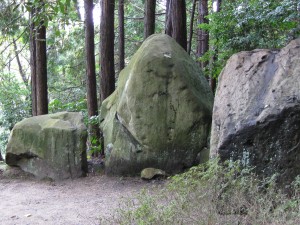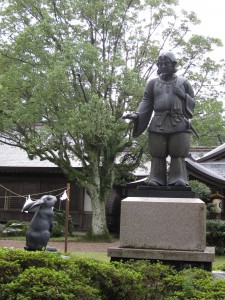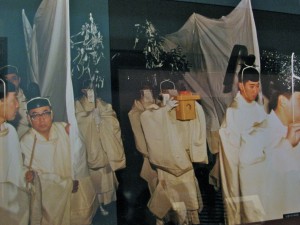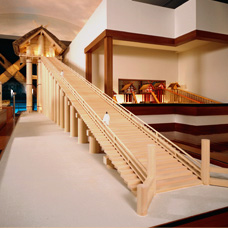2012 is the 1300th anniversary of the Kojiki, fount of Japan’s mythology. In celebration Shimane prefecture has brought out a wonderful website which details the connections of place and folklore found in the myths. I wish I’d had access to this when I made my trip to Izumo last year as the information is both detailed and stimulating. Below are some of the highlights, but for the website itself please click here.
****************************************************************************************

The boulders with which Izanagi supposedly blocked up the underworld
In the Yomi-no-kuni myth, Izanagi rushes out of the underworld pursued by furies released by Izanami and hurriedly blocks up the entrance with a boulder. The Shimane website says,’Yomotsu Hirasaka, the entrance to the underworld, is said to be in the Iya area of Matsue, just off of Route 9. It is a quiet, secluded place that is gloomy even on the clearest day, which creates an atmosphere appropriate to a place said to be a border between this world and the next. Several large boulders are in the area, and one wonders exactly which one was rolled over to block the entrance. Also near this area is Iya Shrine, and a slope near the shrine is said to be the same slope that led to the underworld’s entrance.’
*******************************************************************************************
An animal rights story about the culture hero, Okuninushi:

Okuninushi and the hare, one of Izumo's most famous stories
Okuninushi lived in the land of Izumo in Ashihara-no-nakatsukuni with his numerous brothers. One day, his brothers heard of a goddess of unrivaled beauty named Yagami-hime. She lived in the land of Inaba, and every one of them wanted to ask for her hand in marriage. When they set out for Inaba, they brought Okuninushi along as their servant to carry their baggage, which was so heavy that he soon lagged behind the group.
When his brothers reached Cape Keta in Inaba, they came upon a rabbit lying on the ground that had been stripped of its skin and was crying in pain. The brothers said to the rabbit, “You should wash off in seawater and then climb to the top of a high hill where the winds blow strongly to dry off. You’ll recover very quickly if you do.”
So the rabbit did as it was told, but instead of recovering, things got worse. As the winds blew, its skin dried and cracked, and the salt from the seawater got into its cracked skin. It couldn’t stand the pain, and fell down crying.
When Okuninushi, who was still trailing the group, finally reached Cape Keta, he saw the rabbit crying out in pain, and asked it what had happened… [and what happens next can be found here.]
**************************************************************************

Ceremony on the beach to welcome the eight myriad kami
The Shimane website comments: ‘If you follow the road that passes in front of Izumo Taisha, you will soon arrive at Inasa-no-Hama beach. This beach is part of Sono-no-nagahama, a place that plays a large role in the Kunibiki legend, and is where Takemikazuchi presented Okuninushi with his demands to turn over Ashihara-no-nakatsukuni to Amaterasu, and where Takeminakata challenged him to a test of strength. It is also where, every year at the Kami-mukae-sai, all of the gods from around Japan are welcomed to Izumo Taisha, and the procession back to Izumo Taisha from the beach follows a path through town along the Kami Mukae Road.’
****************************************************************************

Model of how Izumo Taisha might have looked in Heian times
“In April of 2000, an amazing find of archaeological and historical significance was made on the grounds of Izumo Taisha: during construction preparations for an underground storage unit, part of a large wooden pillar was found. Upon further excavation, two other pillars were found next to it, and all three were placed together in such a way that they looked as if they had been bound together to make one massive pillar. More digging nearby uncovered two similar groupings of pillars.
Why was this such an important find? It led credence to the claim that at on point in time, Izumo Taisha’s main hall had been 48 meters high, twice the height it is now. So at some point in the past, the main hall of Izumo Taisha was taller than even the Daibutsu (Great Buddha) Hall of Todai Temple in Nara. Its floor would have been at the point where the current main hall’s ceiling is now, making it higher than the low-lying cloud cover that tends to surround the shrine. This discovery is more evidence that Izumo Taisha and Shimane played a particularly important role in ancient Japan.”

Leave a Reply